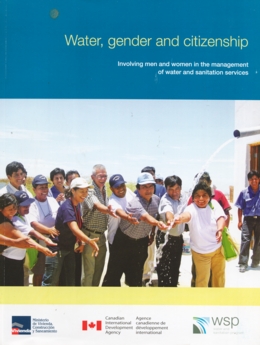 The inclusion of a gender component in initiatives taht seek to improve access to water and sanitation services for the poorest people is a challenge. The challenge is greater when it comes to develop specific tools, which should help integrate the concept of gender in daily work. This document attempts to contribute to the debate on how to promote equal relations between men and women in terms of access to, control and benefits of water and sanitation services, on the basis of a concrete experience.
In the water and sanitation sector in Latin America and the Caribbean significant efforts have been made to include a gender component in policies and strategies. The Water and Sanitation Program (WSP) has promoted the inclusion of gender equity in the projects implemented in the Region, carrying out diagnosis and validating methodologies at three levels: political, institutional and community.
This document is based on the experience of the Small Town Pilot Project in Peru (STPP) in promoting inclusive citizen participation, involving both men and women, in decisions on the management of water and sanitation services in localities having between 2,000 and 30,000 inhabitants. The project was a joint initiative by the Vice Minister of Construction and Sanitation of Peru (VMCS), with the financial support of the Canadian International Development Agency (CIDA) and the technical assistance of the Water and Sanitation Program (WSP) to foster a change of roles in the management of water and sanitation services, which have been traditionally linked to management by local governments, characterized by deficient administration and service. The new model proposes a public, private and social alliance.
The document summarizes what we have learned from the experience of change lived in these localities; in which both men and women were involved in all phases of the project. While evaluating this process, the objective was also to identify the contributing of the inclusion of a gender component towards ensuring equal participation in decision-making, encouraging the demand for quality services, including various perspectives on citizen’s rights and duties in terms of the services and finally it’s contribution towards the building of a better citizen-state relationship.
Index:
Introduction
1. Starting Point
1.1 Gender and citizenship
1.2 The context of the discussion on water and gender
2. Background of the experience
2.1 Context and objectives of the project
2.2 The social situation of women with respect to water and sanitation in the STPP
3. The incorporation of a gender component in the different stages of the project
3.1 Understand in order to inform
3.2 Men and women making decisions
3.3 Negotiation to arrive at a decision: the tarrif issue
3.4 Male and female citizen participation for sustainable management of water and sanitation services
4. Building citizenship: local government, male and female citizens
5. Lessons learned
Bibliography
Post Date : 17 Desember 2009
|
